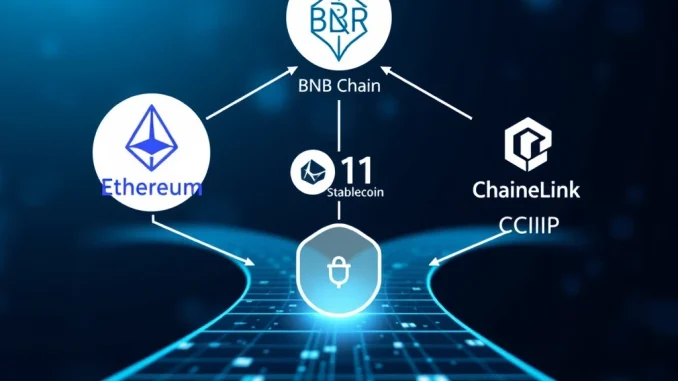
The world of decentralized finance thrives on connectivity, and stablecoins are at the heart of much of that activity. However, moving assets securely and efficiently between different blockchains has historically been a significant challenge. This is where solutions like Chainlink’s Cross-Chain Interoperability Protocol (CCIP) come into play, aiming to create a more unified blockchain ecosystem. A major development in this space is the recent announcement regarding the USD1 stablecoin.
USD1 Stablecoin Goes Cross-Chain: What You Need to Know
World Liberty Financial’s USD1 stablecoin, a key player with a market presence valued at approximately $2 billion, has taken a significant step towards broader accessibility and utility. The stablecoin is now operational across two major blockchain networks: Ethereum and BNB Chain. This expansion is made possible through the integration of Chainlink CCIP.
This move is more than just adding support for new chains; it’s about leveraging advanced infrastructure to ensure secure and reliable cross-chain transfers. The integration specifically utilizes CCIP’s capabilities to facilitate the seamless movement of USD1 tokens between these two distinct blockchain environments.
Why is Cross-Chain Capability Important for Stablecoins?
For a stablecoin like USD1, being available on multiple blockchains offers several key advantages:
- Increased Liquidity: Users on both Ethereum and BNB Chain can now access and utilize USD1 more easily, boosting its overall liquidity across the decentralized finance (DeFi) landscape.
- Expanded Use Cases: USD1 can now be integrated into a wider range of dApps, protocols, and platforms operating on both networks, opening up new possibilities for lending, borrowing, trading, and more.
- Improved Accessibility: Users are not restricted to a single chain, allowing them to choose the network that best suits their needs in terms of transaction costs or speed.
Historically, moving stablecoins between chains often involved complex processes, wrapped assets, or centralized exchanges, each with potential risks or limitations. A native Cross-chain solution aims to simplify this.
How Does Chainlink CCIP Enhance Security?
One of the primary concerns with cross-chain transfers is security. The movement of value between disparate networks presents attack vectors that traditional single-chain security models don’t fully address. Chainlink CCIP is designed to mitigate these risks through its robust architecture.
Key security features of CCIP include:
- Decentralized Network: It relies on a decentralized network of Chainlink oracle nodes to monitor and validate cross-chain transactions.
- Risk Management: CCIP incorporates a risk management network that independently monitors for suspicious activity, providing an additional layer of security.
- Programmable Token Transfers: It supports secure, programmable token transfers, ensuring that tokens are only moved according to predefined rules and conditions.
By using CCIP, World Liberty Financial aims to provide USD1 users with a higher degree of confidence and security when performing cross-chain operations between Ethereum and BNB Chain.
Bridging Blockchains: The Role of a Stablecoin Bridge
The integration effectively creates a secure Stablecoin bridge for USD1 between Ethereum and BNB Chain. Unlike simple token bridges which can sometimes have single points of failure or reliance on multisigs, CCIP is built as a comprehensive interoperability protocol designed for institutional-grade security and reliability.
This infrastructure is crucial for fostering greater Blockchain interoperability, allowing different networks to communicate and interact in a secure and reliable manner. As the blockchain ecosystem continues to grow, the need for such interoperability solutions becomes increasingly critical for the widespread adoption of decentralized applications and digital assets like stablecoins.
What’s Next for USD1 and Cross-Chain Expansion?
According to reports, the integration with Ethereum and BNB Chain is just the beginning. World Liberty Financial plans to add support for more blockchains over time. This phased approach, starting with two major networks and utilizing a secure protocol like Chainlink CCIP, suggests a strategic effort to gradually expand USD1’s presence across the decentralized landscape while prioritizing security and stability.
Conclusion: A Step Towards Seamless Stablecoin Flow
The integration of World Liberty Financial’s USD1 stablecoin with Chainlink CCIP for cross-chain functionality on Ethereum and BNB Chain marks an important development for the stablecoin’s ecosystem and the broader goal of Blockchain interoperability. By leveraging CCIP’s secure and reliable infrastructure, USD1 aims to unlock greater liquidity, expand its utility across multiple networks, and provide users with a safer way to move value cross-chain. This move positions USD1 for broader adoption and highlights the increasing importance of robust Stablecoin bridge solutions in connecting the fragmented world of blockchains.



